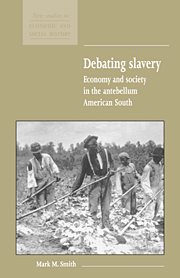Book contents
- Frontmatter
- Contents
- List of figures
- List of tables
- Preface
- 1 The contours of a debate
- 2 Slaveholders and plantations
- 3 Yeomen and non-slaveowners
- 4 Slaves
- 5 The profitability of slavery as a business
- 6 The Profitability of slavery as a system
- 7 New directions, toward consensus
- Bibliography
- Index
- Economic History Society
- New Studies in Economic and Social History
- Studies in Economic and Social History
6 - The Profitability of slavery as a system
Published online by Cambridge University Press: 05 June 2012
- Frontmatter
- Contents
- List of figures
- List of tables
- Preface
- 1 The contours of a debate
- 2 Slaveholders and plantations
- 3 Yeomen and non-slaveowners
- 4 Slaves
- 5 The profitability of slavery as a business
- 6 The Profitability of slavery as a system
- 7 New directions, toward consensus
- Bibliography
- Index
- Economic History Society
- New Studies in Economic and Social History
- Studies in Economic and Social History
Summary
What was the impact of slavery on the southern economy as a whole? Did it retard the growth of towns? What was the level of industrialization in the South? If low, can it be blamed on the slave institution? How important was the South's slave economy to America's economic growth during the antebellum period? Were abolitionists correct in their charge that slavery retarded not just the South but America generally? This chapter considers these larger questions, which speak to the profitability of slavery as a system, in detail.
Industrialization and urbanization
Relative to agricultural cotton production, industry and urban areas were always of secondary importance to the Old South. They were, as one historian has rightly pointed out, exceptions to the southern rule (Parish, 1989). Southern cities, after all, were few and far between and only 13 southern towns had a population of 10,000 or more inhabitants on the eve of the Civil War, with most of these in the border states and around the coast. Peripheral, industrial, and urban growth in the Old South have attracted considerable attention because analyses of industrialization and urbanization during slavery help answer some important questions:
Were the exceptions to the norms of the slave South signs of flexibility, adaptability, and potential for growth and development – or at least useful safety valves for a tension-ridden society – or did they constitute a series of threats to both the efficiency and the stability of the system? In other words, were they a sign of weakness or a source of strength?
(Parish, 1989, p. 98)- Type
- Chapter
- Information
- Debating SlaveryEconomy and Society in the Antebellum American South, pp. 71 - 86Publisher: Cambridge University PressPrint publication year: 1998



